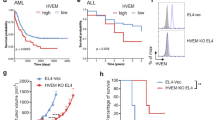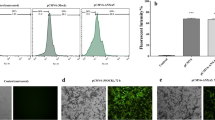Abstract
We have been using PA-1 human teratocarcinoma cells to study mechanisms by which oncogenes induce transformation. Tumorigenic PA-1 cells at passages greater than 100 (>P100) contain a spontaneously activatedN-ras oncogene, while earlier-passage preneoplastic cells contain only the germ-line protooncogene and are nontumorigenic. One preneoplastic cell clone of PA-1 cells can be transformed by introduction of the cloned PA-1N-ras in gene-transfer experiments, while another earlier-passage clonal cell line cannot be transformed. The goal of this investigation was to determine how human cells progress from resistance to susceptibility toras oncogene-induced transformation. Somatic cell hybridization experiments described in this report indicate that the resistance of the low-passage cells to transformation is a dominant trait suppressing transformation. Loss of chromosomes from hybrid segregants suggested that tumor suppressors exist on chromosomes 1, 4, and 11. Extended in vitro passaging of somatic cell hybrids also resulted in the loss of chromosomes. Chromosome 1 was lost in these populations of cells, implying that reduction of this chromosome may promote proliferation and not specifically affect tumor formation.
Similar content being viewed by others
Literature cited
Harris, H., Miller, O.J., Klein, G., Worst, P., and Tachibana, T. (1969).Nature 223363–368.
Harris, H., and Klein, G. (1969).Nature 2241314–1316.
Jonasson, J., Povey, S., and Harris, H. (1977).J. Cell Sci. 24217–254.
Stanbridge, E.J. (1976).Nature 26017–20.
Klinger, H.P. (1982).Cytogenet. Cell Genet. 3268–84.
Benedict, W.F., Weissman, B.E., Mark, C., and Stanbridge, E.J. (1984).Cancer Res. 443471–3479.
Stanbridge, E.J., Flandermeyer, R.R., Daniels, D., and Nelson-Rees, W.A. (1981).Somat. Cell Genet. 7699–712.
Klinger, H.P., and Kaelbling, M. (1986).Cytogenet. Cell Genet. 42225–235.
Saxon, P.J., Srivatsan, E.S., and Stanbridge, E.J. (1986).EMBO J. 53461–3466.
Weissman, B.E., Saxon, P.J., Pasquale, S.R., Jones, G.R., Geiser, A.G., and Stanbridge, E.J. (1987).Science 236175–180.
Weinberg, R.A. (1985).Science 230770–776.
Bishop, J.M. (1987). The molecular genetics of cancer.Science 235305–311.
Land, H., Parada, L.F., and Weinberg, R.A. (1983).Nature 304596–602.
Sinn, E., Muller, W., Pattengale, P., Tepler, I., Wallace, R., and Leder, P. (1987).Cell 49465–475.
Thomassen, D.G., Gilmer, T.M., Annab, L.A., and Barrett, J.C. (1985).Cancer Res. 45726–732.
Sager, R. (1985).Adv. Cancer Res. 4443–68.
Geiser, A.G., Der, C.J., Marshall, C.J., and Stanbridge, E.J. (1986).Proc. Natl. Acad. Sci. U.S.A. 835209–5213.
Oshimura, M., Gilmer, T.M., and Barrett, J.C. (1985).Nature 316636–639.
Koi, M., and Barrett, J.C. (1986).Proc. Natl. Acad. Sci. U.S.A. 835992–5996.
Zeuthen, J., Norgaard, J.O.R., Avner, P., Fellous, M., Wartiovaara, J., Vaheri, A., Rosen, A., and Giovanella, B.C. (1980).Int. J. Cancer 2519–32.
Tainsky, M.A., Cooper, C.S., Giovanella, B.C., and Vande Woude, G.F. (1984).Science 225643–645.
Tainsky, M.A., Shamanski, F., Blair, D., and Giovanella, B.C. (1987).Cancer Res. 473235–3238.
Tainsky, M.A., Krizman, D.B., Chiao, P.J., Yim, S.O., and Giovanella, B.C. (1988).Anticancer Res. 8899–914.
Yoakum, G.H. (1984).Biotechniques 224–29.
Davidson, R.L., and Gerald, P.S. (1976).Somat. Cell Genet. 2165–176.
Knudson, A.G., and Strong, L.C. (1972).J. Natl. Cancer Inst. 48313–324.
Patterson, H., Reeves, B., Brown, R., Hall, A., Furth, M., Bos, J., Jones, P., and Marshall, C. (1987).Cell 51803–812.
Kitayama, H., Sugimoto, Y., Matsuzaki, T., Ikawa, Y., and Noda, M. (1989)Cell 5677–84.
Pizon, V., Chardin, P., Lerosey, I., Olofsson, B., and Tavitian, A. (1988).Oncogene 3201–204.
Author information
Authors and Affiliations
Rights and permissions
About this article
Cite this article
Krizman, D.B., Giovanella, B.C. & Tainsky, M.A. Susceptibility forN-ras-mediated transformation requires loss of tumor suppressor activity. Somat Cell Mol Genet 16, 15–27 (1990). https://doi.org/10.1007/BF01650476
Received:
Revised:
Issue Date:
DOI: https://doi.org/10.1007/BF01650476




